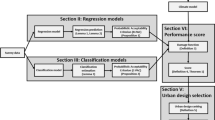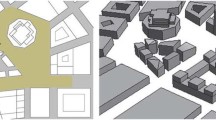Abstract
We develop a novel statistical decision-theoretic framework for urban design from an outdoor thermal comfort (OTC), social and economic perspectives. We combine those aspects into spatio-temporal risk measures which provide a compact representation of the overall quality of an urban design scenarios (UDS) set. We then formulate the selection of the optimal design as an optimization problem which is easy to solve and has a clear interpretation. To illustrate how our framework can be used in practice, we present a real-world study, which is based on a set of UDS that aim to improve the OTC of a specific site in Singapore. We show how our framework provides decision makers the flexibility to make choices relevant to their design objectives, leading to informed and interpretable design option selection.









Similar content being viewed by others
References
Acero, J., Pignatta, G., & Norford, L. (2008). Use of clustered meteorological data for microclimate and thermal comfort analysis in a tropical area, 08 2018.
Ahmed, M. (2017). On statistical risk assessment for spatial processes. Ph.D. dissertation, Université de Lyon.
Algeciras, J. A. R., Consuegra, L. G., & Matzarakis, A. (2016). Spatial–temporal study on the effects of urban street configurations on human thermal comfort in the world heritage city of camagüey-cuba. Building and Environment, 101, 85–101.
Ashrae, A. (2004). Standard 55–2004, thermal environmental conditions for human occupancy. Atlanta: American Society of Heating, Refrigerating, and Air-Conditioning Engineers Inc.
Berger, L., & Marinacci, M. (2017). Model uncertainty in climate change economics. Tech. Rep.
Berger, J. O. (2013). Statistical decision theory and Bayesian analysis. Berlin: Springer.
Bruse, M., et al. (2009). Envi-met 3.1 online manual.
Cetin, M., Adiguzel, F., Kaya, O., & Sahap, A. (2018). Mapping of bioclimatic comfort for potential planning using Gis in Aydin. Environment, Development and Sustainability, 20(1), 361–375.
Chaguetmi, F., & Derradji, M. (2019). Assessment of the environmental quality of neighbourhoods in the context of sustainable development: Case of the Plain West in Annaba, Algeria. Environment, Development and Sustainability, 22, 4563–4588.
Chatzidimitriou, A., & Yannas, S. (2016). Microclimate design for open spaces: Ranking urban design effects on pedestrian thermal comfort in summer. Sustainable Cities and Society, 26, 27–47.
Chen, L., & Ng, E. (2012). Outdoor thermal comfort and outdoor activities: A review of research in the past decade. Cities, 29(2), 118–125.
Chirkin, A. M., & Koenig, R. (2016). Concept of interactive machine learning in urban design problems. New York: ACM.
de Freitas, C. R., & Grigorieva, E. A. (2015). A comprehensive catalogue and classification of human thermal climate indices. International Journal of Biometeorology, 59(1), 109–120.
Föllmer, H. (2014). Spatial risk measures and their local specification: The locally law-invariant case. Statistics & Risk Modeling, 31(1), 79–101.
Greenshields, C. J. (2015). Openfoam user guide. OpenFOAM Foundation Ltd Version, 3(1), 47.
Hartz, D. (2012). Heat-related morbidity and thermal comfort: A comparison study of Phoenix and Chicago. Tempe: Arizona State University.
Heng, S. L., & Chow, W. T. (2019). How ’hot’ is too hot? Evaluating acceptable outdoor thermal comfort ranges in an equatorial urban park. International Journal of Biometeorology, 63(6), 801–816.
Kamble, T., & Bahadure, S. (2019). Neighborhood sustainability assessment in developed and developing countries. Environment, Development and Sustainability, 22, 1–23.
Koch, E. (2018). Spatial risk measures and rate of spatial diversification. arXiv preprint arXiv:1803.07041.
Koch, E. (2017). Spatial risk measures and applications to max-stable processes. Extremes, 20(3), 635–670.
Lam, C. K. C., Gallant, A. J., & Tapper, N. J. (2016). Perceptions of thermal comfort in heatwave and non-heatwave conditions in Melbourne, Australia. Urban Climate, 23, 204–218.
McNeil, A. J., Frey, R., Embrechts, P., et al. (2005). Quantitative risk management: Concepts, techniques and tools (Vol. 3). Princeton: Princeton University Press.
Nevat, I., Peters, G. W., & Collings, I. B. (2013). Random field reconstruction with quantization in wireless sensor networks. IEEE Transactions on Signal Processing, 61(23), 6020–6033.
Nevat, I., Peters, G. W., Septier, F., & Matsui, T. (2015). Estimation of spatially correlated random fields in heterogeneous wireless sensor networks. IEEE Transactions on Signal Processing, 63(10), 2597–2609.
Nouri, A. S. (2015). A framework of thermal sensitive urban design benchmarks: Potentiating the longevity of aucklands public realm. Buildings, 5(1), 252–281.
Paravantis, J., Santamouris, M., Cartalis, C., Efthymiou, C., & Kontoulis, N. (2017). Mortality associated with high ambient temperatures, heatwaves, and the urban heat island in Athens, Greece. Sustainability, 9(4), 606.
Pindyck, R. S. (2013). Climate change policy: What do the models tell us? Journal of Economic Literature, 51(3), 860–72.
Minton, P. D., Raiffa, H., & Schlaifer, R. (1961). Applied statistical decision theory. American Mathematical Monthly, 69, 72.
Savage, L. J. (1972). The foundations of statistics. North Chelmsford: Courier Corporation.
Sodoudi, S., Zhang, H., Chi, X., Müller, F., & Li, H. (2018). The influence of spatial configuration of green areas on microclimate and thermal comfort. Urban Forestry and Urban Greening, 34, 85–96.
Taleghani, M. (2017). Outdoor thermal comfort by different heat mitigation strategies—A review. Renewable and Sustainable Energy Reviews, 81, 2011–2018.
Taleghani, M., Sailor, D., & Ban-Weiss, G. A. (2016). Micrometeorological simulations to predict the impacts of heat mitigation strategies on pedestrian thermal comfort in a los angeles neighborhood. Environmental Research Letters, 11(2), 024003.
Tapias, E., & Schmitt, G. (2014). Climate-sensitive urban growth: Outdoor thermal comfort as an indicator for the design of urban spaces. WIT Transactions on Ecology and the Environment, 191, 623–634.
van Hooff, T., Blocken, B., Hensen, J., & Timmermans, H. (2014). On the predicted effectiveness of climate adaptation measures for residential buildings. Building and Environment, 82, 300–316.
Yang, W., & Wong, N. H. (2013). Field study of human thermal perception in urban parks in Singapore. International Journal of Sustainable Building Technology and Urban Development, 4(2), 125–133.
Acknowledgements
The authors would like to thank Cong Ye, Michelle Chan, Sailin Zhong and Jan Perhac from Singapore-ETH Centre (SEC), Singapore, for their implementation of the design tool in Singapore Views. The research was conducted under the Cooling Singapore project, funded by Singapore’s National Research Foundation (NRF) (Grant No. NRF2019VSG-UCD-001) under its Campus for Research Excellence and Technological Enterprise (CREATE) and its Virtual Singapore programmes. Cooling Singapore is a collaborative project led by the Singapore-ETH Centre (SEC), with the Singapore-MIT Alliance for Research and Technology (SMART), TUMCREATE (established by the Technical University of Munich), the National University of Singapore (NUS), the Singapore Management University (SMU), and the Agency for Science, Technology and Research (A*STAR).
Author information
Authors and Affiliations
Corresponding author
Additional information
Publisher's Note
Springer Nature remains neutral with regard to jurisdictional claims in published maps and institutional affiliations.
Rights and permissions
About this article
Cite this article
Nevat, I., Pignatta, G., Ruefenacht, L.A. et al. A decision support tool for climate-informed and socioeconomic urban design. Environ Dev Sustain 23, 7627–7651 (2021). https://doi.org/10.1007/s10668-020-00937-1
Received:
Accepted:
Published:
Issue Date:
DOI: https://doi.org/10.1007/s10668-020-00937-1




